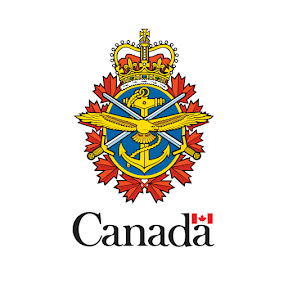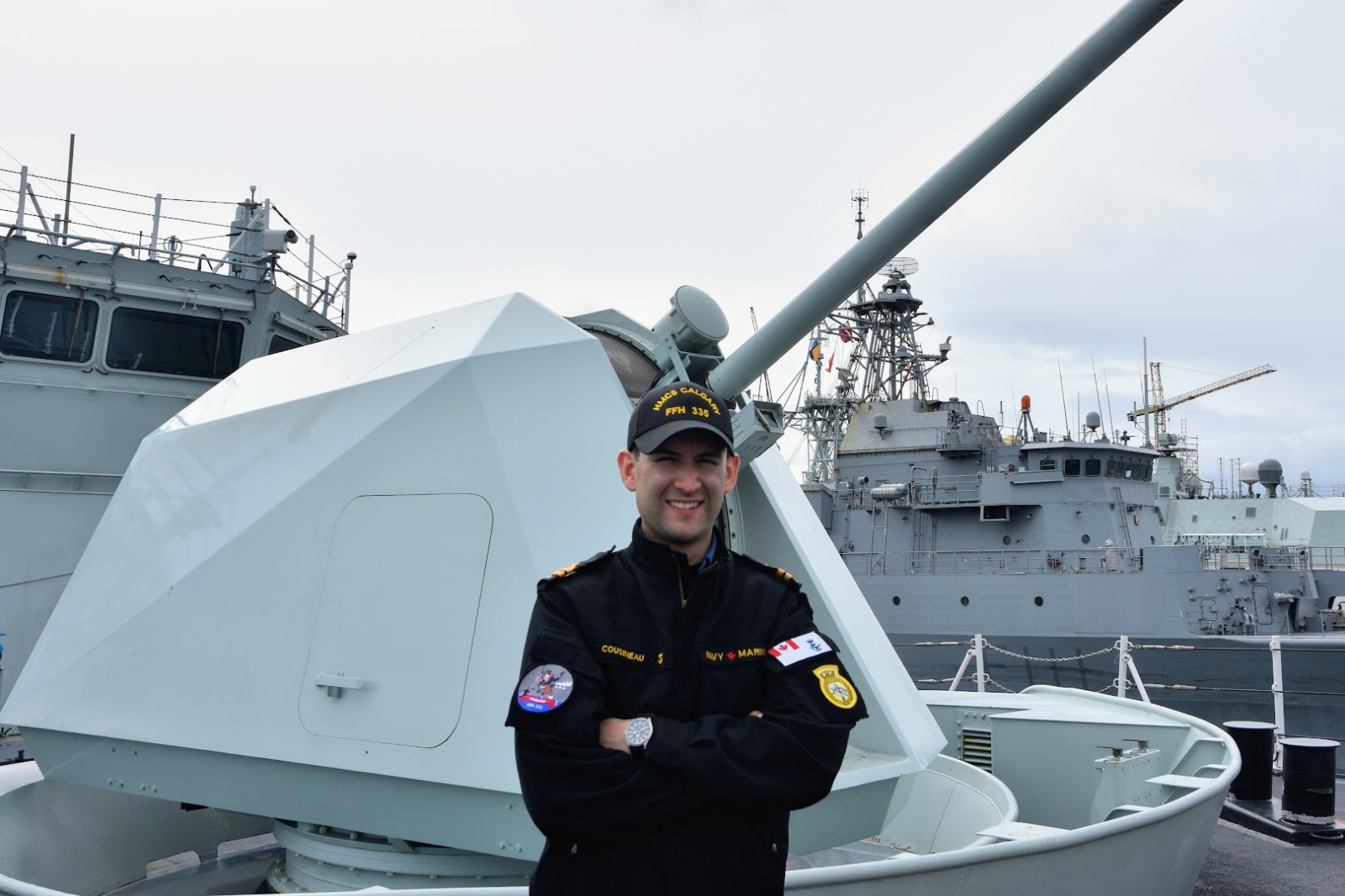Patrick Cousineau
Naval Combat Systems Engineering Officer
Canadian Armed Forces
Learn About My Career
Patrick Cousineau is a Naval Combat Systems Engineering Officer for the Canadian Armed Forces.
I was born/grew up in: I was born and grew up in Sooke, British Columbia.
I now live in: Esquimalt, British Columbia.
I completed my training/education at: I received a Bachelor’s degree in Computer Engineering from the University of Victoria prior to joining the Navy. I then attended training in St. Jean, Quebec, Halifax, Nova Scotia, and Victoria, BC.
I work day-to-day onboard a Canadian Warship, where my job is two-fold. The first half is to lead the many skilled technicians of the Combat Systems Engineering department. The second is to be the “subject matter expert” for all combat systems employed on the ship.
The equipment I’m responsible for is state-of-the-art. Naval Combat Systems Engineering Officers have a high level of technical background knowledge in all systems we work with. This includes the naval guns, missiles, torpedoes, electronic warfare systems, radar, sonar, command & control systems, and communications equipment. We receive in-depth training in how these systems work. This included at the theoretical level (e.g., the math and physics behind how radar works, computer programming, circuit design), all the way up to the functional level using engineering drawings and technical documentation. A background in STEM is extremely important for us in order to work with the many diverse systems.
When we are in home port, I plan and oversee maintenance and make sure that all work stays on schedule. At sea, I make sure that the ship’s combat systems are operational at all times in order to support the current mission. This could be anything from search and rescue, sovereignty patrols, to naval warfare. In order to keep the ship operational, I need to make split-second decisions on how to best diagnose, repair, and employ the many combat systems used by the ship.
What this all boils down to is leadership, decision-making, and problem solving with the end goal of ensuring that the ship is mission capable.
Though this isn’t what I thought I’d be doing when I was in high school, I’m more than happy with where I ended up. After graduating, I attended the University of Victoria for a Bachelor’s degree in Computer Engineering. I studied under the Co-op program, where I had the opportunity to work as a student at companies such as BlackBerry and Reliable Controls. My Co-op terms were my favourite part of university!
I always saw myself joining the Air Force as a pilot. But I decided to join as a Naval Combat Systems Engineering Officer based on my new-found interest in STEM. Immediately following University, I applied to, and was accepted into the Canadian Armed Forces in my current position. I haven’t looked back since! Both my parents had served in the Military, so I’ve always looked fondly at a career in the forces and kind of knew what to expect.
Ever since I was little, I’ve always been interested in the military and their equipment. Now, I’m immersed in it every day. I get to work with high-tech systems in an environment that’s totally unique and unlike any other engineering job. Not everyone can say that their office is mobile and can sail all over the world! I joined the navy to minimize my time working in a cubicle/office, and I’ve had many opportunities to be on-ship and travel.
The Royal Canadian Navy commonly performs missions with a large positive impact on the public. This includes such things as Search and Rescue, humanitarian aid, disaster relief, etc. Additionally, when deployed oversees, warships represent Canada and perform diplomatic missions. In my day-to-day work as a manager of my department, I get to make sure that my subordinates get what they want and need out of their careers. It is very rewarding at the end of the day.
I love being outside; I camp and off-road year round. I also enjoy hiking and fishing. I’ve played the Bass Guitar since high school, and play in a Metal band regularly. Being in the military has given me lots of time to keep up with my hobbies, and we get dedicated time during the workday for physical fitness!
Talk to a recruiter if you have any questions about the Forces! I’d highly recommend any career in the CAF, especially if you’re interested in STEM and like to work with high-tech systems.
What I do at work
I work day-to-day onboard a Canadian Warship, where my job is two-fold. The first half is to lead the many skilled technicians of the Combat Systems Engineering department. The second is to be the “subject matter expert” for all combat systems employed on the ship.
The equipment I’m responsible for is state-of-the-art. Naval Combat Systems Engineering Officers have a high level of technical background knowledge in all systems we work with. This includes the naval guns, missiles, torpedoes, electronic warfare systems, radar, sonar, command & control systems, and communications equipment. We receive in-depth training in how these systems work. This included at the theoretical level (e.g., the math and physics behind how radar works, computer programming, circuit design), all the way up to the functional level using engineering drawings and technical documentation. A background in STEM is extremely important for us in order to work with the many diverse systems.
When we are in home port, I plan and oversee maintenance and make sure that all work stays on schedule. At sea, I make sure that the ship’s combat systems are operational at all times in order to support the current mission. This could be anything from search and rescue, sovereignty patrols, to naval warfare. In order to keep the ship operational, I need to make split-second decisions on how to best diagnose, repair, and employ the many combat systems used by the ship.
What this all boils down to is leadership, decision-making, and problem solving with the end goal of ensuring that the ship is mission capable.
My career path is
Though this isn’t what I thought I’d be doing when I was in high school, I’m more than happy with where I ended up. After graduating, I attended the University of Victoria for a Bachelor’s degree in Computer Engineering. I studied under the Co-op program, where I had the opportunity to work as a student at companies such as BlackBerry and Reliable Controls. My Co-op terms were my favourite part of university!
I always saw myself joining the Air Force as a pilot. But I decided to join as a Naval Combat Systems Engineering Officer based on my new-found interest in STEM. Immediately following University, I applied to, and was accepted into the Canadian Armed Forces in my current position. I haven’t looked back since! Both my parents had served in the Military, so I’ve always looked fondly at a career in the forces and kind of knew what to expect.
I am motivated by
Ever since I was little, I’ve always been interested in the military and their equipment. Now, I’m immersed in it every day. I get to work with high-tech systems in an environment that’s totally unique and unlike any other engineering job. Not everyone can say that their office is mobile and can sail all over the world! I joined the navy to minimize my time working in a cubicle/office, and I’ve had many opportunities to be on-ship and travel.
How I affect peoples’ lives
The Royal Canadian Navy commonly performs missions with a large positive impact on the public. This includes such things as Search and Rescue, humanitarian aid, disaster relief, etc. Additionally, when deployed oversees, warships represent Canada and perform diplomatic missions. In my day-to-day work as a manager of my department, I get to make sure that my subordinates get what they want and need out of their careers. It is very rewarding at the end of the day.
Outside of work I
I love being outside; I camp and off-road year round. I also enjoy hiking and fishing. I’ve played the Bass Guitar since high school, and play in a Metal band regularly. Being in the military has given me lots of time to keep up with my hobbies, and we get dedicated time during the workday for physical fitness!
My advice to others
Talk to a recruiter if you have any questions about the Forces! I’d highly recommend any career in the CAF, especially if you’re interested in STEM and like to work with high-tech systems.
When I was a student I enjoyed:
- Art
- Computer Science
- Industrial Arts / Shop Programs
- Math
- Music
- Physical Education/Health
- Science
- Technology
When I was a student, I would describe myself as someone who:
- Always wanted to be outside
- Played on a sports team
- Enjoyed working with my hands
- Was motivated by success
- Wanted to be in charge
- Liked being given specific instructions
- Liked being given free range to explore my ideas
- Engaged in volunteer activities
- Liked reading
- Felt at home in the outside, natural environment
- Played video games
- Was really creative
- Felt great satisfaction in getting good grades
- Learned best “by doing”
- Liked to take things apart to see how they worked
- Liked to design or build things
Partners

Canadian Armed Forces
Let’s Talk Science thanks the men and women of Canadian Armed Forces who have submitted a career profile to share details of their exciting careers. To learn more about the careers available in the Canadian Armed forces, check them out on YouTube, Instagram, Twitter, or Facebook.
Related Topics
Explore More Career Profiles
-
Brianna Lummerding
Career Profiles
Agronomic Innovation Manager
I look after all things related to soil management for a group of retailers. -
Li Tan (he/him)
Career Profiles
Molecular Lead
I coordinate the day-to-day operations in the DNA Extraction Lab. -
Tyler Morhart (video)
Career Profiles
Scientist, Beamline Responsible - SyLMAND
I am responsible for the SyLMAND beamline at the Canadian Light Source synchrotron facility. -
Li Tan (Video)
Career Profiles
Molecular Lead
I coordinate the day-to-day operations in the DNA Extraction Lab. -

Rashell Featherstone (she/her)
Career Profiles
Senior Program Associate
I coordinate projects for the development of new products at STEMCELL. -

Kira Hoffman (she/her)
Career Profiles
Postdoctoral Researcher/Fire Ecologist
I am a researcher at both a university and a not-for profit organization where I am gaining experience to become a senior researcher. -
Zoë Ehlert (Video)
Career Profiles
Manager, Marker Assisted Breeding
I lead a team that develops canola crops by breeding plants with traits we are looking for. -
Zoë Ehlert
Career Profiles
Manager, Marker Assisted Breeding
I lead a team that develops canola crops by breeding plants with traits we are looking for. -
Jennifer Baltzer (she/her)
Career Profiles
Professor and Canada Research Chair in Forests and Global Change
I work at a university, teaching students and conducting research on the impact of climate change on forests in Canada and around the world. -

Caitlyn Lyons (she/her)
Career Profiles
Ph.D. Candidate
I am working towards my PhD and studying the forests in the Northwest Territories. -

Joann Whalen
Career Profiles
Professor at the Faculty of Agricultural and Environmental Sciences,
I teach advanced courses on how to manage soils to produce healthy, nutritious food and maintain healthy ecosystem functions.

